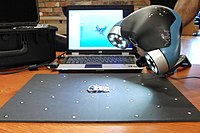
Photo from wikipedia
Large segmented-mirror telescopes are powerful tools used in modern astronomy. Segmentation of the primary mirror is important for support design, mirror fabrication, and construction cost reduction. A curvature study showed… Click to show full abstract
Large segmented-mirror telescopes are powerful tools used in modern astronomy. Segmentation of the primary mirror is important for support design, mirror fabrication, and construction cost reduction. A curvature study showed that a primary mirror with a solid angle of less than π/6 can be well divided by projecting identical hexagonal tilings onto a curved surface. Three approaches, based on map projection, are presented. The conformal method, preserving the angle locally, provides optimal regularity. The equal-area algorithm generates a partition having zero area variation. The equidistant projection minimizes the circumscribed diameter of the segments. These approaches are unified by a newly proposed compromise approach, which provides the necessary adjustment range for individual preferences. The performances of the three approaches are numerically verified using the Thirty Meter Telescope model. This study verifies the effectiveness of the scaling rule and sheds light on the mechanism of primary mirror segmentation.
Journal Title: Applied optics
Year Published: 2021
Link to full text (if available)
Share on Social Media: Sign Up to like & get
recommendations!